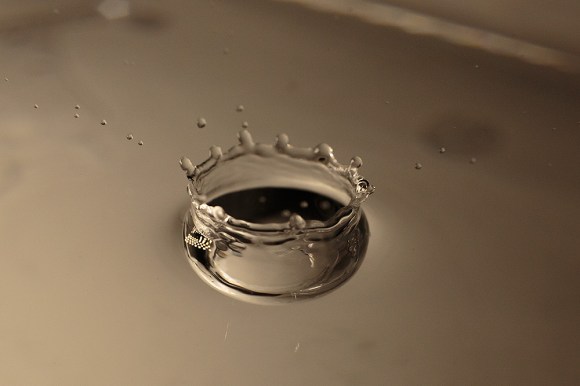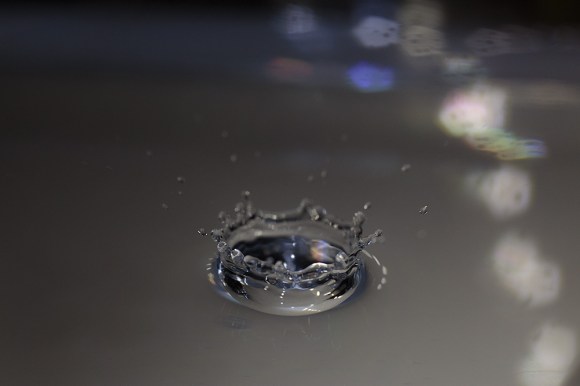
Ever wonder how they capture seemingly perfectly timed photographs of water droplets? Most of the time it’s done by using an optointerrupter whereby it detects the droplet falling and then triggers a light source a few milliseconds later with your camera ready and waiting.
This is typically done with something called an air gap flash, which is usually rather expensive or difficult to make, but [Michal’s] figured out another easier way suitable for some applications — using an array of LEDs to illuminate the scene.
He’s got a IR diode, a photo-resistor, a few spacers, some plastic and a bunch of hot glue to make up his optointerrupter. When the droplet passes through the IR beam it breaks the signal from the photo-resistor which then triggers his ATmega48P. It waits 80 milliseconds (he timed it out) and then turns on the LEDs for approximately 50 microseconds. Meanwhile his camera is watching the whole event with a shutter-speed of a few seconds.
This works because LEDs have rise and fall times that are much shorter than a traditional camera flash — normal flashes light up for 1-2 milliseconds, as opposed to this 50 microsecond LED flash. Just take a look at some of the pictures!

















+1 ~ the perfect beholding moment too!!!
+1 for using a photo-transistor not a photo-resistor as is mentioned above. Even a run of the mill low end photo-transistor that Radio Shack sells has faster response than the typical LDR photo-resistor that seems to get utilized in projects of this type (beam interruption or beam reflection).
I’m glad I’m not the only one who was worried/frustrated about that. I was trying to use a CdS photoresistor for a colorsensor (with RGB LED) in a robotics project recently, but I found that the settling time for a standard CdS cell is nearly 0.2 seconds. I could only get 1Hz color measurements.
What about using nanosecond timing with regular LEDs? What kind of image could be done? -> http://arxiv.org/ftp/arxiv/papers/1011/1011.1954.pdf
Thinking further, would be possible to turn a regular diode laser into a nano-second laser with this approach? 2PP 3DP ? Well, I went too far – I think. Anyway, great job.
The drop photos are quite nice, however this only demonstrate equivalent time stopping capability to that of a quality xenon camera flash with igbt switch: ~1/20000 s. Not to say that LEDs couldn’t be made to do better and for little cost compared to a good speedlite. Well done.
So presumably the setup allows other things besides drops of water to be photographed going into the water, like small pebbles or Lego Minifigs?
It’d be interesting to see some pics of other things at the moment of splashdown.
1 drop of milk into clean water looks awesome!
Normal, Xenon lamp based flashes are much faster. AFAIK whole strobe lasts on the order of microsecond or so.
Not quite but they are on par. A high quality flash like a Canon 430EX or Nikon SB-900 will hit around 50us at around 1/32 power. The best ones go to around 20us at their lowest power setting but that’s about it. At full power speedlights are actually quite slow as in >1millisecond
You don’t need full power for water drops and similar high speed settings. I usually use minimum power (1/64) on some cheap flash, in a dark room and shutter in bulb mode.
I agree that if you can achieve similar speed with leds, it opens a lot of posibilites to play with the lighting, (A ring over the the splash zone, multicolored light, etc…)
Low end flash at minimum power, usualy lasts 1/20000s Prety fast.
For the break beam, I’m using a http://www.vishay.com/docs/82458/tssp4038.pdf with very good results.
I’m looking to test with some 100mA leds in place of the flash. This hack encourages me, to try.
https://picasaweb.google.com/lh/photo/aPTbe8vQNeI_10qwIIbWf9MTjNZETYmyPJy0liipFm0?feat=directlink
Adding an electrovalve and programable timing, you could achieve coliding drops photos.
About LDR vs Phototransistor.. Settling speed don’t maters as long as the travel time of the water drop is long enough, and is consistent. It maters for other tipes of break beam photography, like insects and birds.
BTW… Forgot to mention I only use break beam for wildlife photo…. For whater drops I rely on the firing of the valve.
“Normal flashes” do not “light up for 1-2 milliseconds”. Even the least expensive ones can go well below 1 ms. Speed of 1/20000s is common (50 microsecond).
That old stalwart CHDK which has been featured on HAD more than once, can produce some pretty impressive results without any additional equipmnt.
http://chdk.wikia.com/wiki/Samples:_High-Speed_Shutter_%26_Flash-Sync
You do need a supported Canon camera though, but a lot of older models (Ixus 50 and imilar vintage) turn up used on fleabay for a few bucks.
I did something with a phototransistor, and a arduino+LCD+potmeter, dSLR with flash on short shutter time and the delay was adjustable with the potmeter on the arduino. So i was able to make pictures of the drop just touching the water, or add some more delay and see crowns like above and all in between.
CameraAxe is really flexible for high speed photography, and you can make it yourself because schematics and code are available. http://www.cameraaxe.com/
Excellent set-up! The image quality is unbelievable.
I experimented with LEDs for the very same purpose. There is one more thing you can do compared to normal flashes: You can light the LEDs multiple times for the same drop, creating superimposed images.
My set-up used an MCU with a serial-to-usb cable and a simple terminal emulation in order to tweak all parameters (waiting time, flash duration, number of flashes, etc.) I only used one Cree XM-L, which proved a little weak.
At any rate, experimenting with drops is really addictive. Try it! There are so many parameters to change, like drop height, water depth, timings, water/milk/oil/colours and so on.
I just want to mention that I like those clamps.
What camera was he using? Is there a cheap digital camera that will do this? I’d hate to go back to my old Pentax and deal with processing film.
Cool project, but the writeup has a number of errors. I’m heavily involved in all sorts of high speed photography topics so I’d like clear up a few things. (I’m not bashing this project. I think it’s great. But I do want to put more correct info out there.)
“Most of the time it’s done by using an optointerrupter whereby it detects the droplet falling and then triggers a light source a few milliseconds later with your camera ready and waiting.” — That’s how this project works, but it is not how most people who photograph droplets do things. To get interesting water droplet photos you need to collide droplets in midair. To do that people control solenoids with microcontrollers to release the drops with precise timing. Here are some of my water droplet photos that require multiple droplets: https://www.flickr.com/photos/mauriceribble/sets/72157637155126135/
“This is typically done with something called an air gap flash” — Not true. I’ve made airgap flashes for photographing higher speed events like a shooting bullet, but there is no reason to use them with water droplets. Droplets just don’t move fast enough to need anything more than a standard canon/nikon/yongnuo xenon flash. Yongnuo flashes have a duration of about 35 microseconds which is more than fast enough to capture water droplets without blur. I like Yongnou because they are about a quarter of the price of Canon/Nikon flashes and they work just as good for water droplets. LED are cool, but they actually won’t produce quite as nice of image as a xenon flash.
“This works because LEDs have rise and fall times that are much shorter than a traditional camera flash — normal flashes light up for 1-2 milliseconds” — Typical flashes today are triggered with mosfets and have a minimum duration of about 30-40 microseconds. Even studio flashes which don’t use high speed mosfets (they use bleed resistors instead) still have a duration of .5 to 1 millisecond or faster. I don’t know of any xenon flash that has a duration of 2 milliseconds.
I’ve done around a dozen videos about different aspects of water droplet photography. Here is one of the about some cool software that auto-calibrates the drop collision: http://www.techphotoblog.com/tpb-59/
Of course all this code and hardware is open source and can be downloaded here: http://www.cameraaxe.com/programming/
This can also be done by simply watching the frequency at which the drops fall and manually popping a flash. You can get pretty good at timing the flash to whatever part of the splash you want, and just cherry-pick the best ones. A pro photographer once showed me this and it’s how I made this image:
https://www.flickr.com/photos/rynage/6410043607/